Your Inner Green Man Has Many Faces: From Gentle Giant to Raging Tyrant
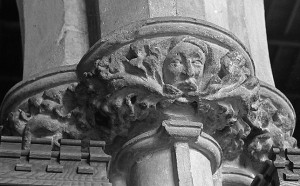
The Green Man – one of our powerful hidden archetypes – emerge from behind the leaves. Photo by Simon Garbutt.
Who is your inner Green Man, really?
Is he more than a yearning for nature; as in a desire for vacationing outdoors? Is he more than a craving for late-summer fruits and vegetables?
Is your Green Man more than your growing awareness of how important it is to “go green” in your home and workplace?
Have you even heard him emerge as the voice inside you that says – in the midst of some high-falutin’ corporate presentation – This is all so silly!
We know that our inner Green Man is one of our oldest cultural archetypes; his imagery shows up in many old English churches – along with images of other pre-Christian symbols. He comes to us from across our ancient European cultures, and shows up as the god Pan in Greek mythology. In short, the Green Man has been with us for a very long time.
But how does our Green Man show up in our recent mythology – that is, in the way that we tell ourselves our deep stories?
This is important, because for each of us, our Green Man is a part of who we are. He is one of our eight core archetypes, identified by Carl Jung (as a condensed version of the sixteen core archetypes that form his Psychological Types). The more that we understand each of our eight core archetypes, the more that we understand (and can intelligently manage) ourselves.
Let’s have a look – into realms from fairy tales to commercials to the heroic myths created in our movies.
The Green Man Is … the Jolly Green Giant!
Who says “Ho, ho, ho” and is NOT Santa Claus?
One of the first Green Man images that comes to mind – for those of us of a certain age – is no less than the Jolly Green Giant – personified and made eponymous by the Green Giant food company. To this day, canned peas and the Jolly Green Giant are forever linked in my memory.
This Jolly Green Giant incarnation is a positive aspect of the Green Man; one who is genial and outgoing, and who fosters lush growth in fields and gardens.
However, our Green Man also has a dark side.
The Green Man Has a Dark Side

The Giant from the fairytale ‘Jack and the Beanstalk’ and the even more recent movie Jack the Giant Slayer.
In the fairy tale Jack and the Beanstalk, young hero Jack climbs up a giant beanstalk to encounter – and ultimately defeat – a vengeful giant; the one who says “Fee fi fo fum!” This is a mean giant; a Green Man who has gone over to the “dark side.”
Those of you who are interested in deeper interpretations might visit Lectures at Califia on Folklore by Marjorie C. Luesebrink, with a good Jungian overview.
I’ve found Neil Leyden’s piece on The Seven Basic Story Plots very interesting, citing Christopher Booker in his book The Seven Basic Plots. Also, Jeff Cook wrote an excellent essay on Jack’s Quest for Maturity about the Jack and the Beanstalk story. All of these interpret the Giant as a vengeful father-figure, whom Jack must defeat in order to gain maturity.
It’s true; the Green Man’s “dark side” can represent a raging father figure; a tyrant whom we must overcome in our quest for maturity and self-reliance. However, when we deal with the Green Man’s more positive aspect, we can integrate him instead of defeating him.
One of the important things that is starting to emerge here is that our Green Man represents our wild side. He is the only archetype (among our eight core archetypes) to be this associated with wildness and with nature.
Our Green Man Uses Feelings and Actions – Not Words – to Communicate
Our Green Man is not particularly verbal. From the Jungian perspective, he can be Extroverted (Jolly Green Giant) or Introverted (the quiet Green Man of the Woods). Whether introverted or extroverted, we know that he is Sensing, rather than Intuitive. He relies on what his senses – and his immediate experience – tell him. His truth comes from what he sees, what he hears, and what he touches and senses under his feet as he walks through the woods.
It’s not that our Green Man can’t form intuitive connections. Rather, his reality is grounded in his direct and pragmatic experience.
In the octant graph above, our Green Man shows up in the lower left. He is a masculine (Jungian Psychological Types Judging) archetype (all the ones on the lower half are masculine). He is a Feeling archetype. (All the archetypes on the left-hand-side are Feeling; those on the right are Thinking.) He is also a Sensing archetype; you’ll see that in the octant graph, Sensing archetypes alternate with Intuiting.
Our Green Man is Feeling, rather than Thinking. He doesn’t need abstract thoughts. He gets his reality from his feelings; from observing and interacting with people, animals, plants, and his surrounding world – not with thoughts about this world.
Finally, our Green Man is a masculine archetype, and so is more Judging than Perceiving. That means, despite being oriented towards the expansive feeling of the great outdoors, he is likely to want to do something rather than simply be aware of potentials and possibilities. He’s action-oriented, and inclined to do things that bring about concrete, tangible results – even if the “result” is only to see the view from the top of the next hill!
Hagrid in the Harry Potter Series – the World’s Most Famous Green Man
Perhaps the best – and most well-known – Green Man character portrayal in the entire world is Rubeus Hagrid from the various Harry Potter books.
Hagrid certainly gives us a great insight into the Green Man’s character and day-to-day life!
In Hagrid, we see some exemplary Green Man characteristics:
- This Green Man lives apart from others, and his home is more situated in nature – even though Hagrid, as the Gamekeeper, is an integral part of the Hogwarts School and wizardly community, he lives apart from the others in a separate (and more rustic) home – he prefers the woods to stone walls, and is comfortable venturing into the Dark Forest,
- He leads with his heart – not with his mind – true to being a Feeling-type, Hagrid follows his heart – first, last, and always,
- As a prototypical Green Man, Hagrid love animals – the stranger the better – who else but Hagrid would introduce Buckbeak (the Hippogriff), as well as Fang (the Boarhound), Fluffy (a giant three-headed dog), Norberta (a Norwegian Ridgeback dragon), and many others,
- As with all Green Men, Hagrid is a giant – he is exuberant and “larger than life,” and
- Hagrid is fiercely and unquestioningly loyal to those whom he loves.
With this kind of character, don’t we all need a Hagrid in our lives?
Hodor is a Green Man
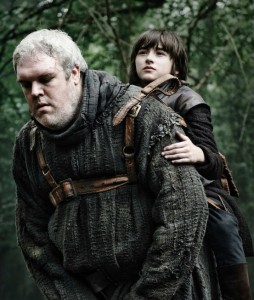
In the Game of Thrones, Hodor is a loyal and devoted Green Man figure.
The character Hodor, whom we meet in the first book, A Game of Thrones, in George Martin’s epic series Song of Ice and Fire, is a beautiful Green Man in current mythology.
Since we’ve just done a mini-Jungian analysis of the Green Man archetype, we can understand Hodor – and thus our own inner Green Man – more completely.
Hodor is not particularly verbal. In fact, he can say only one word – his own name.
This makes sense from the Jungian analysis; he is Sensing – not Intuiting. He is Feeling, not Thinking. His reality is his surrounding world, not thoughts about his world.
Just as with Hagrid in the Harry Potter book series, in Hodor we continue to see our Green Man’s extreme loyalty to those whom he loves. Hodor is unquestioningly loyal and devoted. In particular, he protects the physically disabled Bran, and carries him about from place to place.
In this, we have a perfect Jungian pairing: Bran is highly Intuitive. In fact, Bran’s calling is to enter the shapeshifter’s world ; he begins his own series of shamanic journeys. This is the “far side” of being Intuitive. Practically speaking, since he is crippled, Bran needs to be paired with someone who lives in the physical world in order to get around. That becomes Hodor’s job.
Bran is Intuitive and Thinking. Hodor is Sensing and Feeling. Hodor is totally devoted to Bran. Working together, they make a great team.
This gives us a clue about how we do our own integration. We do need to access our own Green Man; we can’t constantly neglect and ignore him.
Practically, this means that – even if we are immersed in a creative project or in building our empire – we must occasionally break for a walk in the woods. We need to spend time refreshing ourselves with nature. We need to pay attention to the way in which we are living on the planet. This is what will “carry us” through our creative and empire-building challenges.
In terms of our daily life: if we give even modest attention to our inner Green Man, he is there for us when we need him. And when times are hard, he’ll see us through. We can count on him to protect and serve.
His exuberance will lighten spirit. His willingness to pick up our heavy load will lighten our passage.
The Ents in Tolkien’s Lord of the Rings – Our Green Man Aids Us in Battle
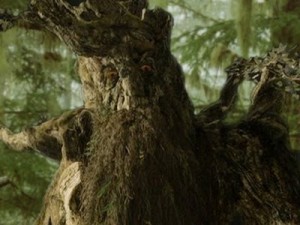
Treebeard, an Ent featured in Tolkien’s book the War of the Ring, is a Green Man figure.
Who could be more of a Green Man than the Ent Treebeard?
Ents, from Tolkein’s books The Hobbit and The Lord of the Rings saga, are prototypical Green Men. Once again, we can learn a lot about the Green Man aspect of ourselves by looking at the Ents, as well as the Huorn (Ents who have become more “treelike”).
As we become more attuned with nature, we feel more of a kinship with the Huorn, as described by Inga Simpson.
As Inga writes:
The Huorn are ancient, primeval, old growth; they remember a time when trees ruled Middlearth, before the awakening of elves and the rise of men. The Huorn are still angry at the impact of men and elves and dwarves and orcs on their world, harbouring resentments across the ages. Elves, it seems to me, should be welcome among trees; their only fault was a kinship to men. But I am not a tree.
When the Ents and the Huorn come to the aid of Aragorn in the Lord of the Rings saga, The Two Towers (Book Three), we see their terrible power unleashed against the Orcs.
This is a powerful lesson for us.
In a later post, I’ll do a more complete analysis of our core archetypes in The Lord of the Rings. For now, it suffices to say that this is a story of integration as well as a major Heroic Journey, on the part of both Frodo and Aragorn.
It is Aragorn who calls together all aspects of who he is as he confronts forces that seem much greater than himself and his allies. When Aragorn draws on the power of the Ents, he unleashes a fierce and primal force; devastating the evil Orcs.
There are times in our own lives when we need to thow everything that we have, and everything that we can draw upon, into some noble cause. It is at this time that we draw fully on our own primal reserves. We pull from that aspect of ourselves that which can be fierce in battle. This is a time for unleashing our full power; not for the restraint of civilized niceties.
We do not recognize this force-within-ourselves during our day-to-day lives. It lies in our deep reserve. This power has a “voice” that takes much time and patience to discern. However, if we have previously made connection (as Aragorn did with Treebeard), then we can tap this huge reserve when needed.
To your own health, wealth, success, and overall well-being –
Alay’nya (Alianna J. Maren, Ph.D.)
Author of Unveiling: The Inner Journey
You are the Jewel in the Heart of the Lotus. Become the Jewel!
Check out Alay’nya’s YouTube Channel
Connect with Alay’nya on Facebook
Follow Unveiling: The Inner Journey on Facebook
A Portable Identity, by Debra Bryson and Charise Hoge – for Those of Us Doing both an External and Inner Journey!
Unveiing is about the Inner Journey; Charise Hoge, MSW, has written an excellent book about what happens when we take a literal journey to a far-off land – and how it can trigger huge personal growth.
A Portable Identity, available from Amazon in both trade paper and Kindle forms, is for anyone who will be moving abroad, or who will even be undertaking a big life transition. Whether the life-change is a divorce, leaving a corporate job to start life as an entrepreneur, leaving a life of military service to start a new civilian job, or even the children leaving home, this is an important and useful book, with helpful guided exercises throughout.
Both Cherise and co-author Debra Bryson share deeply of their personal stories, as they evolved during their years abroad. From the initial point of departure, with their thoughts of how they would each “handle” their new lives abroad, to the challenges, stumbles, and eventual victories, their stories are not only their own; they are every woman’s.
As we read A Portable Identity, it doesn’t matter whether or not we have ever physically lived abroad – we all undertake similarly disruptive life-journeys that ultimately shape us into deeper and wiser beings. A Portable Identity, by Debra Bryson and Charise Hoge, is a valuable companion to the inner growth that happens when we make a shift in our external world.
|
Paper
|
Kindle
|
|||
This blog series develops themes originally published in Unveiling: The Inner Journey, published by Mourning Dove Press.
Unveiling currently has twenty 5-star Amazon reviews, and has been recommended by luminaries:
- Dr. Christiane Northrup – “This book is delightful”
- Midwest Book Review, in Bethany’s Books – reviews by Susan Bethany – “highly recommended”
- Nizana al Rassan, writing for (the now out of circulation) iShimmy.com – “a fascinating read with so much wisdom and solid advice.”
Cherise Hoge, Co-Author of A Portable Identity, on Unveiling: The Inner Journey
What does Charise Hoge, co-author of A Portable Identity as well being a counselor and dancer, have to say about Unveiling: The Inner Journey?
From Charise Hoge’s Amazon review of Unveiling:
Alay’nya achieves something vitally important with her intimate writing style — she invites you to look within yourself and take responsibility for how your life is going. For me, the book was experiential – as I read “shift state”, I shifted state, I tapped into how this feels internally. When I read about “softening” and “allow[ing] the veil to drop,” I connected with this precious vulnerability. When I read about going into the underworld of my psyche to attend to any woundedness there, I felt encouraged, willing. There are also tips and exercises at the close of each chapter to be proactive with your discoveries, but the book as a whole is transformative. It has an energetic charge that only a writer proficient in movement arts can convey! Take the invitation to go on the inner journey, this book will carry you safely there.
Read this and more reviews of Unveiling: The Inner Journey.
|
Paper
|
Kindle
|
|||
Copyright (c) 2013, Alay’nya (Alianna J. Maren, Ph.D.). All rights reserved.

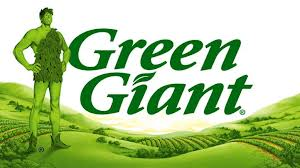
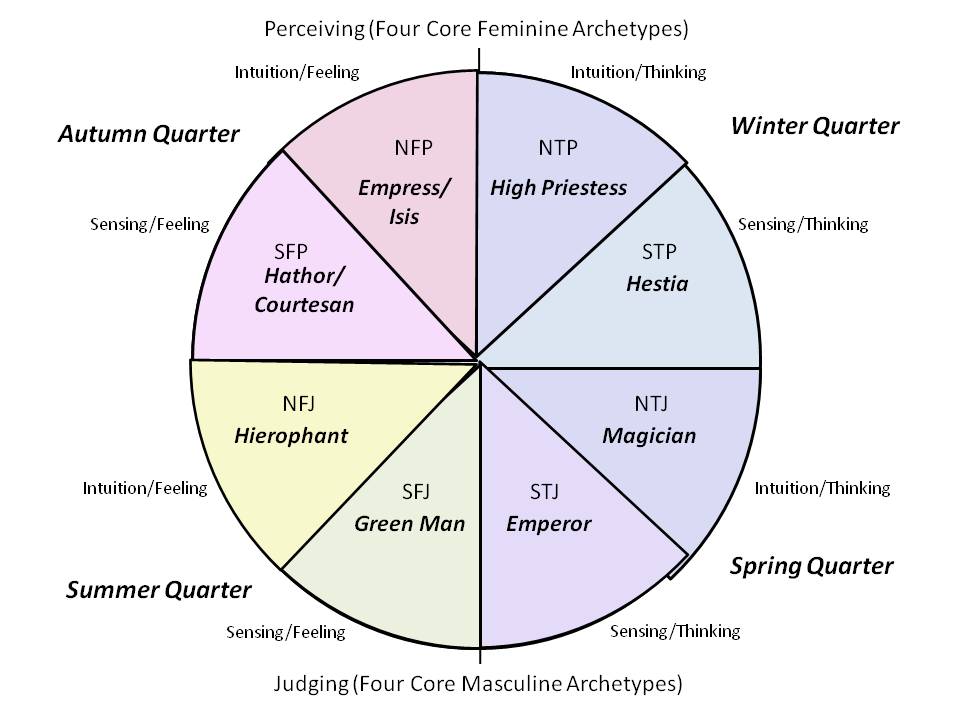
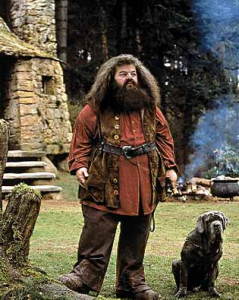


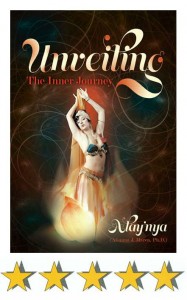
Pingback: When Your Inner “Green Man” Breaks from Cover | Unveiling: The Inner Journey